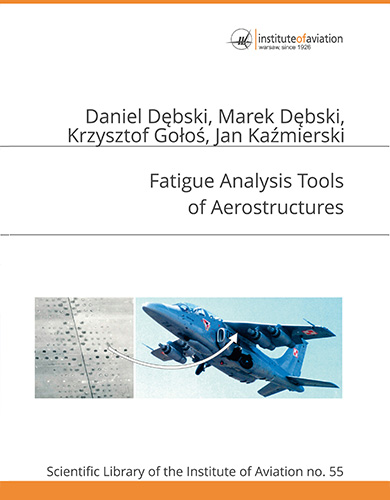Author: Daniel Dębski, Marek Dębski, Krzysztof Gołoś, Jan Kaźmierski
Title: Fatigue Analysis Tools of Aerostructures
ISBN: 978-83-63539-46-7
Cover: paperback, glued binding
The year of publication: 2018
Publisher: Scientific Publishers of the Institute of Aviation
Quantity pages: 164
Language of publication: english
Description: This monograph is the result of significant participation of the authors in the implementation of scientific and research programmes such as the research programme of the training and combat aircraft PZL I-22 Iryda, several national and two European scientific and research programmes, cooperation with Polish and foreign aviation companies and own works and research. They were carried out mainly at the Institute of Aviation, as well as at the Warsaw University of Technology at the Faculty of Automotive and Construction Machinery Engineering.
Chapter 1 of this paper presents a review, comparison and analysis of methods for
the assessment of fatigue strength of bearing structures of aircraft. The examples of fatigue tests of PZL I-22 Iryda aircraft were used.
This allowed the authors to take a critical look at the basic issues of analytical methods of assessing the fatigue life of the structure. As a result, a number of new hypotheses concerning fatigue strength of materials and structures were formulated. These issues are discussed in Chapter 2.
Chapter 3 concerns the development of the Continuous Fatigue Lifetime Assessment Method for airborne structures as a result of striving for full and uniform use of fatigue life of the supporting structure (not only for airborne structures).
The admission of structures to service with controlled fatigue damage development (Fail-Safe or Damage Tolerance concept) requires the detection and observation of critical areas of the structure’s superstructure during service. Chapter 4 shows examples of fatigue critical areas of aircraft structure.
One of the essential elements of the Fatigue Lifetime Assessment Method is the need to continuously monitor fatigue loads of the structure under normal operating conditions. For this reason, measurement systems have been developed and implemented for both hardware and software and for signal analysis. These issues are discussed in Chapter 5.
Chapter 6 presents an innovative (patented) solution for the connection of structural elements of the supporting structure by means of so-called composite nodes. This solution increases fatigue life and reduces the weight of the structure, as shown in the DEKO 9 Magic acrobatic plane’s fuselage fatigue tests.

